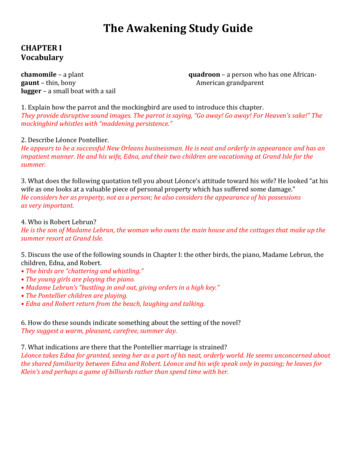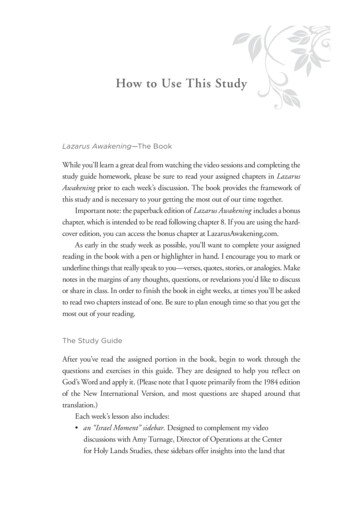
Transcription
the WINGS toAWAKENINGAn Anthology from the Pali CanonTranslated and Explained byThanissaro Bhikkhu(Geoffrey DeGraff)for free distribution
2Copyright h›nissaro Bhikkhu 1996This book may be copied or reprinted for free distributionwithout permission from the publisher.Otherwise all rights reserved.Cover Art Art Matrix. Used with permissionSeventh edition, revised: 2013
3So this is what you think of me: “The Blessed One,sympathetic, seeking our well-being, teaches theDhamma out of sympathy.” Then you should trainyourselves—harmoniously, cordially, and withoutdispute—in the qualities I have pointed out,having known them directly: the four frames ofreference, the four right exertions, the four bases ofpower, the five faculties, the five strengths, theseven factors for Awakening, the noble eightfoldpath.—MN 103
4ContentsAcknowledgmentsAbbreviationsPreface: How to Read This BookA Table of the Wings to AwakeningI. The Seven SetsII. The Factors of the Seven Setsclassed under the Five FacultiesIntroductionPART I: BASIC PRINCIPLESA. SkillfulnessB. Kamma & the Ending of KammaPART II: THE SEVEN SETSA. The Treasures of the TeachingB. The Four Frames of ReferenceC. The Four Right ExertionsD. The Four Bases of PowerE. The Five FacultiesF. The Five StrengthsG. The Seven Factors for AwakeningH. The Noble Eightfold PathPART III: THE BASIC FACTORSA. ConvictionB. PersistenceC. MindfulnessD. Concentration: Abandoning the HindrancesE. Right ConcentrationF. Concentration & DiscernmentG. Equanimity in Concentration & DiscernmentH. Discernment: Right Viewi. The Four Noble Truthsii. The First Truthiii. The Second & Third Truthsiv. The Fourth TruthGlossaryIndexBibliography
5AcknowledgmentsThis book has been several years in the making. In the course ofassembling it I have used some of the material it contains to lead studycourses at the Barre Center of Buddhist Studies, Barre, Massachusetts; atAwareness Grove, Laguna Beach, California; with the Insight MeditationSociety of Orange County, the San Diego Vipassana Community, and theOpen Door Sangha of Santa Barbara. The feedback coming from theparticipants in these courses has helped force me to clarify thepresentation and to make explicit the connections between the words ofthe teachings and their application in practice. It has been encouraging tosee that people in America—contrary to their reputation in other parts ofthe world—are interested in learning authentic Buddhist teachings andintegrating them into their lives. This encouragement is what has givenme the impetus to turn this material into a book.In addition to the participants at the above courses, Dorothea Bowen,John Bullitt, Jim Colfax, Charles Hallisey, Karen King, Mu Soeng, AndrewOlendzki, Gregory M. Smith, and Jane Yudelman have read and offeredvaluable comments on earlier incarnations of the manuscript. John Bullittalso helped with the Index. The finished book owes a great deal to all ofthese people. Any mistakes that remain, of course, are my ownresponsibility.I dedicate this book to all of my teachers, and in particular to PhraAjaan Lee Dhammadharo, the teacher of my primary teacher, Phra AjaanFuang Jotiko. The example of Ajaan Lee’s life has had a large influence onmy own, in more ways than I can ever really repay. His teaching of theBuddhist path as a skill—as expressed in the Wings to Awakening andembodied in the practice of breath meditation—provided the original andon-going inspiration for writing this book. I offer it to his memory withthe highest respect. h›nissaro BhikkhuMetta Forest MonasteryPO Box 1409Valley Center, CA 92082
6AbbreviationsPali Buddhist TextsANDhpDNItiMNMvSNSnThagThigUdAºguttara Nik›yaDhammapadaDıgha Nik›yaItivuttakaMajjhima Nik›yaMah›vaggaSaªyutta Nik›yaSutta nces to DN, Iti, and MN are to discourse (sutta). References to Dhp areto verse. The reference to Mv is to chapter, section, and sub-section. Referencesto other texts are to section (saªyutta, nip›ta, or vagga) and discourse.All translations are the author’s own, and are based on the Royal Thai Editionof the Pali Canon (Bangkok: Mahamakut Rajavidyalaya, 1982).Other AbbreviationsCommlitPTSvlCommentaryliteral meaningPali Text Societyvariant readingIn the translated passages, parentheses ( ) enclose alternative renderings andwords needed to make sense of the passage. Square brackets [ ] encloseexplanatory information, cross-references, material summarized from longerpassages in the text, and other material not found in the original text. Braces { }enclose material interpolated from other passages in the Canon; the source of thismaterial is indicated in braces as part of the citation at the end of the passage.Because Pali has many ways of expressing the word “and,” I have—to avoidmonotony—used the ampersand (&) to join lists of words and short phrases, andthe word “and” to join long phrases and clauses.In passages where no speaker is identified, the words are the Buddha’s.
7PrefaceHOW TO READ THIS BOOKMany anthologies of the Buddha’s teachings have appeared in English, but this isthe first to be organized around the set of teachings that the Buddha himself saidformed the heart of his message: the Wings to Awakening (bodhi-pakkhiyadhamma). The material is arranged in three parts, preceded by a longIntroduction. The Introduction tries to define the concept of Awakening so as togive a clear sense of where the Wings to Awakening are headed. It does this bydiscussing the Buddha’s accounts of his own Awakening, with special focus onthe way in which the principle of skillful kamma (in Sanskrit, karma) formedboth the “how” and the “what” of that Awakening: the Buddha was able toreach Awakening only by developing skillful kamma—this is the “how”; hisunderstanding of the process of developing skillful kamma is what sparked theinsights that constituted Awakening—this is the “what.”With this background established, the remainder of the book focuses in detailon the Wings to Awakening as an expanded analysis of the “how.” Part Onefocuses on aspects of the principle of skillful kamma that shaped the way theWings to Awakening are formulated. Part Two goes through the seven sets thatmake up the Wings to Awakening themselves: the four foundations ofmindfulness (here called the four frames of reference), the four right exertions,the four bases for power, the five faculties, the five strengths, the seven factorsfor Awakening, and the noble eightfold path. Part Three reduces all the terms inthe seven sets to the five faculties and then deals with those faculties in detail.With the fifth and final faculty, discernment, the book concludes by returning tothe “what” of Awakening, showing how discernment focuses on the Wingsthemselves as topics to be observed in such a way that they will spark theinsights leading to total release.Thus the organization of the book is somewhat circular. As with any circle,there are several points where the book can be entered. I would recommend twoto begin with. The first is to read straight through the book from beginning toend, gaining a systematic framework for the material from Parts One and Two,which explain why the seven sets are organized as they are, and then focusingmore on individual elements in the sets in Part Three. This way of approachingthe material has the advantage of giving an overall perspective on the topicbefore going into the details, making the role and meaning of the details clearfrom the start. However, this approach is the reverse of what actually happens inthe practice. A practicing meditator must learn first to focus on individualphenomena in and of themselves, and then, through observation andexperimentation, to discover their inter-relationships. For this reason, somereaders—especially those who find the discussion of causal relationships in PartsOne and Two too abstract to be helpful—may prefer to skip from theIntroduction straight to sections A through E of Part Three, to familiarize
8themselves with teachings that may connect more directly with their ownexperience. They may then return later to Parts One and Two to gain a moreoverall perspective on how the practice is meant to deal with those experiences.Regardless of which approach you take to the material, you should discoverfairly quickly that the relationships among the overall patterns and individualelements in the Wings are very complex. This complexity reflects the non-linearnature of the Buddha’s teachings on causal relationships, and is reflected in themany cross-references among the various parts of the book. In this way, thestructure of this book, instead of being a simple circle, is actually a pattern ofmany loops within loops. Thus a third way to read it—for those familiar enoughwith the material to want to explore unexpected connections—would be tofollow the cross-references to see where they lead.Parts One through Three of the book are each divided into sections consistingof passages translated from discourses in the Pali Canon, which is apparently theearliest extant record of the Buddha’s teachings. Each section is introduced,where necessary, with an essay. These essays are printed in sans serif type todistinguish them clearly from the translated passages. They are attempts toprovide context—and thus meaning—for the passages, to show how they relateto one another, to specific issues in the practice, and to the path of practice as awhole. They are not meant to anticipate or answer every possible questionraised by the passages. Instead, they are aimed at giving an idea of the kinds ofquestions that can be most fruitfully brought to the passages, so that the lessonscontained in the passages can properly be applied to the practice. As the Buddhahas pointed out, the attitude of “appropriate attention” (yoniso manasik›ra), theability to focus on the right questions, is one of the most important skills todevelop in the course of the practice. This skill is much more fruitful than anattitude that tries to come to the practice armed with all the right answers inadvance.The context provided by the essays is threefold: doctrinal, placing thepassages within the structure of the Buddha’s teachings taken as a whole;historical, relating them to what is known of the intellectual and social history ofthe Buddha’s time; and practical, applying them to the actual practice of theBuddhist path in the present.The first and foremost sources for the doctrinal context are the discourses inthe Canon itself. The Buddha and his noble disciples are by far the most reliableguides to the meaning of their own words. Often a teaching that seems vague orconfusing when encountered on its own in a single discourse becomes clearerwhen viewed in the context of several discourses that treat it from a variety ofangles, just as it is easier to get a sense of a building from a series of picturestaken from different perspectives than from a single snapshot.This approach to understanding the discourses is instructive not only whendiscourse x explicitly defines a term mentioned in discourse y, but also whenpatterns of imagery and terminology permeate many passages. Two cases inpoint: in separate contexts, the discourses compare suffering to fire, and thepractice of training the mind in meditation to the art of tuning and playing amusical instrument. In each case, technical terms—from physics in the firstinstance, from music theory in the second—are applied to the mind in a large
9number of contexts. Thus it is helpful to understand where the terms are comingfrom in order to grasp their connotations and to gain an intuitive sense—basedon our own familiarity with fire and music—of what they mean.In a few instances, I have cited alternative versions of the discourses—such asthose contained in the Sarv›stiv›din Canon preserved in Chinese translation—tothrow light on passages in the Pali. Although the Sarv›stiv›din Canon as a wholeseems to be later than the Pali, there is no way of knowing whether particularSarv›stiv›din discourses are earlier or later than their Pali counterparts, so thecomparisons drawn between the two are intended simply as food for thought.I have also drawn occasionally on the Pali Abhidhamma and commentaries,which postdate the discourses by several centuries. Here, however, I have had tobe selective. These texts employ a systematic approach to interpreting thediscourses that fits some teachings better than others. There are instances wherea particular teaching has one meaning in terms of this system, and another whenviewed in the context of the discourses themselves. Thus I have taken specificinsights from these texts where they seem genuinely to illuminate the meaningof the discourses, but without adopting the overall structure they impose on theteachings.To provide historical context, I have drawn on a variety of sources. Again, theforemost source here is the Pali Canon itself, both in what it has to say explicitlyabout the social and intellectual milieu of the Buddha’s time, and in what it saysimplicitly about the way the intellectual disciplines of the Buddha’s time—such asscience, mathematics, and music theory—helped to shape the way the Buddhaexpressed his thought. I have also drawn on secondary sources where these do auseful job of fleshing out themes present in the Pali Canon. These secondarysources are cited in the Bibliography.Because the Pali tradition is still a living one, the doctrinal and historicalcontexts do not account for the full range of meanings that practicing Buddhistscontinue to find in the texts. To provide this living dimension, I have drawn onthe teachings of modern practice traditions where these seem to harmonize withthe message of the Canon and add an illuminating perspective. Most of theseteachings are drawn from the Thai Forest Tradition, but I have also drawn onother traditions as well. I have followed a traditional Buddhist practice in notidentifying the sources for these teachings, and for two reasons: first, in manyways I owe every insight offered in this book to the training I have receivedfrom my teachers in the Forest Tradition, and it seems artificial to credit them forsome points and not for others; second, there is the possibility that I havemisunderstood some of their teachings or taken them out of context, so I don’twant to risk crediting my misunderstandings to them.In providing a more modern context for the passages presented in this book,however, I have not tried to interpret the teachings in terms of modernpsychology or sociology. The Buddha’s message is timeless and direct. It doesnot need to be translated into the passing fashions of disciplines that are in manyways more removed than it is from the realities of direct experience, and morelikely to grow out of date. However, there are two modern disciplines that Ihave drawn on to help explain some of the more formal aspects of the Buddha’smode of speech and his analysis of causal principles.
10The first discipline is phenomenology, the branch of philosophy that dealswith phenomena as they are directly experienced, in and of themselves. Thereare many schools of modern phenomenology, and it is not my purpose to try toequate the Buddha’s teachings with any one of them. However, the Buddha doesrecommend a mode of perception that he calls “entry into emptiness (suññat›)”[see MN 121], in which one simply notes the presence or absence of phenomena,without making further assumptions about them. This approach resembles whatin modern philosophy could be called “radical phenomenology,” a mode ofperception that looks at experiences and processes simply as events, with noreference to the question of whether there are any “things” lying behind thoseevents, or of whether the events can be said really to exist [see passages §230 and§186]. Because of this resemblance, the word “phenomenology” is useful inhelping to explain the source of the Buddha’s descriptions of the workings ofkamma and the process of dependent co-arising in particular. Once we knowwhere he is coming from, it is easier to make sense of his statements and to usethem in their proper context.I have made similar use of modern science—chaos theory in particular. Thereare many parallels between Buddhist theories of causation and moderndeterministic chaos theory. Examples and terminology drawn from the latter—such as feedback, scale invariance, resonance, and fluid turbulence—are veryuseful in explaining the former. Again, in using these parallels I am not trying toequate Buddhist teachings with chaos theory or to engage in pseudo-science.Fashions in science change so rapidly that we do the Buddha’s teachings no favorin trying to “prove” them in light of current scientific paradigms. Here I amsimply pointing out similarities as a way of helping to make those teachingsintelligible in modern terms. Deterministic chaos theory is the only modern bodyof knowledge that has worked out a vocabulary for the patterns of behaviordescribed in Buddhist explanations of causality, and so it seems a natural sourceto draw on, both to describe those patterns and to point out some of their lessobvious implications.In doing so, I realize that I run the risk of alienating non-scientists who feelintimidated by scientific terminology, as well as scientists who resent theapplication of terminology from their disciplines to “non-scientific” fields. Toboth groups I can say only that the terms in and of themselves are not“scientific.” Much of our current everyday terminology for explaining causalrelations is derived from the science of the eighteenth century; I expect that it willonly be a matter of time before the terminology of more recent science willpercolate into everyday usage. For the purpose of this book, it is important topoint out that when the Buddha talked about causality, his notion of causalrelations did not correspond to our ordinary, linear, picture of causal chains. Ifthis point is not grasped, the common tendency is to judge the Buddha’sdescriptions of causality against our own and to find them either confusing orconfused. Viewing them in the light of deterministic chaos theory, however,helps us to see that they are both coherent and of practical use.Another example of an analogy drawn from modern science is the term“holographic,” which I have used to describe some formulations of the Buddhistpath. When a hologram is made of an object, an image of the entire object—albeit fairly fuzzy—can be made from even small fragments of the hologram. In
11the same way, some formulations of the path contain a rough version of theentire path complete in each individual step. In my search for an adjective todescribe such formulations, “holographic” seemed the best choice.If you are unfamiliar with the terminology of phenomenology, chaos theory,and holograms, read section I/A, on skillfulness, to find the doctrinal context inwhich these terms can be related to an immediate experience: the process ofdeveloping a skill. The approach of phenomenology relates to the fact that, onthe night of his Awakening, the Buddha focused his attention directly on themental process of developing skillful states in the mind, without referring to whoor what was developing the skill, or to whether there was any sort ofsubstratum underlying the process. Chaos theory relates to the patterns ofcausality that the Buddha discerned while observing this process, whereby theeffects of action can in turn become causal factors influencing new action.Holography relates to his discovery that skillfulness is developed by takingclusters of good qualities already present in the mind and using them tostrengthen one another each step along the way. Once these familiar referencepoints are understood, the abstract terms describing them should become lessforeign and more helpful.In providing doctrinal, historical, and practical context based on all the abovementioned sources, the essays are meant to give an entry into the mentalhorizons and landscape of the texts they introduce. They are also meant tosuggest how the texts may be used for their intended purpose: to help eliminateobstacles to the release of the mind. Although some of the essays addresscontroversial questions, the textual passages are not meant to prove the pointsmade in the essays. In assembling this anthology, I first gathered and translatedthe passages from the Canon. Only then, after contemplating what I hadgathered, did I add the essays. For this reason, any reader who disagrees withthe positions presented in the essays should still find the translations useful forhis/her own purposes. I am painfully aware that some of the essays, especiallythose in Part I, tend to overpower the material they are designed to introduce,but this is because the themes in Part I play a pervasive role in the Buddha’steachings as a whole. Thus I had to deal with them in considerable detail to pointout how they relate not only to the passages in Part I but also to themes raised inthe rest of the book.Although the essays should go far toward familiarizing the reader with theconceptual world and relevance of the textual passages, there are other aspectsof the passages that might prove daunting to the uninitiated, and so I would liketo deal with them here.To begin with, the teachings on the Wings to Awakening are interrelated invery complex ways. Because books must be arranged in linear sequence, takingone thing at a time in a row, this means that no book can do justice to all the sideavenues and underground passageways that connect elements in one set ofteachings to those in another. For this reason, I have organized the material inline with the order of the sets as given in the Canon, but—as mentioned above—have extensively cross-referenced it for the sake of readers who want to exploreconnections that fall outside the linear pattern. Cross-references are given inbrackets [ ], and take three forms. An example that looks like this—[§123]—is areference to a passage from the Pali Canon translated in this book. One that
12looks like this—[III/E]—is a reference to an essay introducing a section, in thiscase Section E in Part III. One that looks like this—[MN 107]—is a reference to apassage from the Pali Canon not translated here. The abbreviations used in theselast references are explained on the Abbreviations page. Many passages falling inthis last category are translated in my book, The Mind Like Fire Unbound, inwhich case the reference will include the abbreviation MFU followed by thenumber of the page on which the passage is located in that book. My hope is thatthese cross-references will open up useful lines of thought to whoever takes thetime to explore them.Another potential difficulty for the uninitiated reader lies in the style of thepassages. The Pali Canon was, for 500 years, an entirely oral tradition. As aresult, it tends to be terse in some areas and repetitive in others. I’ve made aneffort to cut out as many of the repetitions as possible, but I’ll have to ask yourpatience for those that remain. Think of them as the refrains in a piece of music.Also, when the Buddha is referring to monks doing this and that, keep in mindthat his audience was frequently composed entirely of monks. Thecommentaries state that the word “monk” includes anyone—male or female, layor ordained—who is serious about the practice, and this meaning should alwaysbe kept in mind. I apologize for the gender bias in the translations. Although Ihave tried to figure out ways to minimize it, I find myself stymied because it is sothoroughly embedded in a literature originally addressed to monks.I trust, however, that none of these difficulties will prove insurmountable,and that you will find, as I have, that the teachings of the Pali Canon more thanreward the effort put into exploring them. The reality of the Wings toAwakening lies in the qualities of the mind. The words with which they areexpressed in the Pali Canon are simply pointers. These pointers have to be testedin the light of serious practice, but my conviction is that, of all the meditationteachers the human race has ever seen, the Buddha is still the best. His wordsshould be read repeatedly, reflectively, and put to test in the practice. My hope ingathering his teachings in this way is that they will give you useful insights fortraining the mind so that someday you won’t have to read about Awakening,but will be able to know it for yourself.
13A Table of the Wings to AwakeningI. The Seven SetsThe Four Frames of Reference (satipa h›na)1. Remaining focused on the body in & of itself—ardent, alert, & mindful—putting aside greed & distress with reference to the world.2. Remaining focused on feelings in & of themselves—ardent, alert, &mindful—putting aside greed & distress with reference to the world.3. Remaining focused on the mind in & of itself—ardent, alert, & mindful—putting aside greed & distress with reference to the world.4. Remaining focused on mental qualities in & of themselves—ardent, alert, &mindful—putting aside greed & distress with reference to the world.The Four Right Exertions (sammappadh›na)1. Generating desire, endeavoring, arousing persistence, upholding &exerting one’s intent for the sake of the non-arising of evil, unskillful qualitiesthat have not yet arisen.2. Generating desire, endeavoring, arousing persistence, upholding &exerting one’s intent for the sake of the abandoning of evil, unskillful qualitiesthat have arisen.3. Generating desire, endeavoring, arousing persistence, upholding &exerting one’s intent for the sake of the arising of skillful qualities that have notyet arisen.4. Generating desire, endeavoring, arousing persistence, upholding &exerting one’s intent for the maintenance, non-confusion, increase, plenitude,development, & culmination of skillful qualities that have arisen.The Four Bases of Power (iddhip›da)1. Developing the base of power endowed with concentration founded ondesire & the fabrications of exertion.2. Developing the base of power endowed with concentration founded onpersistence & the fabrications of exertion.3. Developing the base of power endowed with concentration founded onintent & the fabrications of exertion.4. Developing the base of power endowed with concentration founded ondiscrimination & the fabrications of exertion.
14The Five Faculties (indrıya)1. The faculty of conviction (saddhindrıya).2. The faculty of persistence (viriyindrıya).3. The faculty of mindfulness (satindrıya).4. The faculty of concentration (sam›dhindrıya).5. The faculty of discernment (paññindrıya).The Five Strengths (bala)1. The strength of conviction (saddh›-bala).2. The strength of persistence (viriya-bala).3. The strength of mindfulness (sati-bala).4. The strength of concentration (sam›dhi-bala).5. The strength of discernment (paññ›-bala).The Seven Factors for Awakening (bojjhaºga)1. Mindfulness as a factor for Awakening (sati-sambojjhaºga).2. Analysis of qualities as a factor for Awakening (dhamma-vicayasambojjhaºga).3. Persistence as a factor for Awakening (viriya-sambojjhaºga).4. Rapture as a factor for Awakening (pıti-sambojjhaºga).5. Calm as a factor for Awakening (passaddhi-sambojjhaºga).6. Concentration as a factor for Awakening (sam›dhi-sambojjhaºga).7. Equanimity as a factor for Awakening (upekkh›-sambojjhaºga).The Noble Eightfold Path (ariya-magga)1. Right view (samm›-di hi).2. Right resolve (samm›-saºkappa).3. Right speech (samm›-v›c›).4. Right action (samm›-kammanta).5. Right livelihood (samm›-›jıva).6. Right effort (samm›-v›y›ma).7. Right mindfulness (samm›-sati).8. Right concentration (samm›-sam›dhi).
15II. The Factors of the Seven Setsclassed under the Five FacultiesConvictionRight Speech (Eightfold Path)Right Action (Eightfold Path)Right Livelihood (Eightfold Path)Desire (Bases of Power)PersistenceRight Effort (Eightfold Path)Four Right ExertionsPersistence (Bases of Power)Persistence (Factors for Awakening)MindfulnessFour Frames of ReferenceRight Mindfulness (Eightfold Path)Intent (Bases of Power)Mindfulness (Factors for Awakening)ConcentrationFour Bases of PowerRight Concentration (Eightfold Path)Rapture (Factors for Awakening)Calm (Factors for Awakening)Concentration (Factors for Awakening)Equanimity (Factors for Awakening)DiscernmentRight View (Eightfold Path)Right Resolve (Eightfold Path)Analysis of Qualities (Factors for Awakening)Discrimination (Bases of Power)Equanimity (Factors for Awakening)
16IntroductionThe Wings to Awakening constitute the Buddha’s own list of his most importantteachings. Toward the end of his life he stated several times that as long as theteachings in this list were remembered and put into practice, his message wouldendure. Thus the Wings cover, in the Buddha’s eyes, the words and skills mostworth mastering and passing along to others.T H E B U D D H A ’ S A WA K E N I N GWhen discussing the Buddha’s teachings, the best place to start is with hisAwakening. That way, one will know where the teachings are coming from andwhere they are aimed. To appreciate the Awakening, though, we have to knowwhat led Prince Siddhattha Gotama—the Buddha before his Awakening—to seekit in the first place. According to his own account, the search began manylifetimes ago, but in this lifetime it was sparked by the realization of theinevitability of aging, illness, and death. In his words:I lived in refinement, utmost refinement, total refinement. My father evenhad lotus ponds made in our palace: one where red lotuses bloomed, onewhere white lotuses bloomed, one where blue lotuses bloomed, all for mysake. I used no sandalwood that was not from V›r› ası. My turban wasfrom V›r› ası, as were my tunic, my lower garments, & my outer cloak.A white sunshade was held over me day & night to protect me from cold,heat, dust, dirt, & dew.I had three palaces: one for the cold season, one for the hot season, onefor the rainy season. During the four months of th
insights that constituted Awakening—this is the “what.” With this background established, the remainder of the book focuses in detail on the Wings to Awakening as an expanded analysis of the “how.” Part One focuses on aspects of the principle of skillful kamma that shaped the wa










